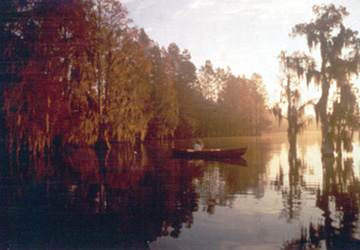

 |
||||||
 |
||||||
Tampa Bay's Reality Check
By Mary Kelley Hoppe
It’s easy to point out what we don’t want Tampa Bay to become: southern California sprawl, the gridlocked northeast, mish-mashed Texas or the unaffordable northwest.
It’s harder to define where we want to be – but decisions made today will definitely impact what Tampa Bay looks like in the future.
“Growth is either going to happen to us or we can shape it, direct it and guide it so it’s the kind of growth we’ll benefit from,” says Stuart Rogel, executive director of the Tampa Bay Partnership, the region’s economic development arm.
“We need to make smart choices today if we’re going to protect the natural resources that sustain our region and the quality of life that drew so many of us here in the first place,” adds Dick Eckenrod, director of the Tampa Bay Estuary Program.
Recognizing that growth is inevitable is helping to bring diverse stakeholders – including those who are occasionally on opposite sides of the table – together for Reality Check, a regional planning exercise designed to help the region chart its future. Spearheaded by the Tampa Bay Partnership and Urban Land Institute of Tampa Bay, Reality Check’s sponsors include the Tampa Bay Estuary Program, Tampa Bay Regional Planning Council and the Southwest Florida Water Management District.
Scheduled for May 18 at the Tampa Convention Center, the one-day visioning exercise is a chance for participants to discuss, analyze and develop alternative growth scenarios for the rapidly growing region through 2050. By then, the seven-county region is expected to grow to 7 million people, adding 3.2 million new residents and 1.5 million jobs.
“First and foremost, I hope people walk away with a greater awareness of the sheer magnitude of growth we’re expecting as a region,” says Rogel. “It’s always surprising to me when I’m talking with people knowledgeable about the issues and tell them we’re getting 800 to 1200 new residents each day – and they’re amazed,” he says.
Not Just Another Plan
Reality Check departs from traditional visioning exercises with its hands-on approach to community design. To start, the 300 participants were selected by an executive committee that strived for diversity, working to balance geography, race, gender, and economic status, as well as public and private interests.
 |
|
Travel time to work has increased an average of 20% in the 10 years from 1990 to 2000. Without careful planning, growth will increase gridlock on the roads. |
Working in teams of 10, facilitators will guide participants in creating a blueprint for growth based on actual demographic, population and economic data compiled for the exercise. Teams will then be tasked with plotting out their vision on detailed maps using color-coded Lego building blocks to represent new homes and jobs and mixed uses in varying densities, and ribbons to mark new or enhanced roads, transit and rail. The event is designed to get people thinking about the inter-relationships between regional land use, transportation and natural resources.
Organizers acknowledge it’s a tall order. Participants will have extensive amounts of supporting data to consider within a tight timeframe. All projected growth must be allocated by the end of the exercise. How teams decide where people will live and work will be based on the guiding principles each team develops. That process starts with discussions about core values, encompassing a host of considerations from preserving green space and protected lands to minimizing sprawl by increasing urban densities and reinvesting in existing urban centers and infrastructure.
“This is the most exciting citizen involvement exercise I have been associated with," said Manny Pumariega, executive director of the Tampa Bay Regional Planning Council. "Participants will learn first-hand the challenges and opportunities facing the region.”
From Vision to Implementation
From the 30 scenarios developed in the morning’s team exercises, participants will vote to select the top four to six choices. Those scenarios will then be subjected to rigorous evaluations over the coming months to test their feasibility before organizers share the outcomes of those analyses with the community in future forums.
 |
|
Photo courtesy Tampa Hillsborough CVB |
The Tampa Bay Estuary Program, for example, is offering modeling assistance to evaluate what effect various growth scenarios will have on water quality in the bay. The question is not simply about geography or where growth will occur, Eckenrod says, but also about how sites are designed and constructed.
Whether and to what extent local communities embrace and implement low impact development and “green building” standards that improve energy, water and environmental efficiencies in homes and businesses, for instance, could alter outcomes dramatically.
“It’s all about implementation,” says Reality Check Project Manager Amy Maguire. “This will not be a study on a shelf, but a living document.”
Maguire hopes to broaden the community conversation on what Tampa Bay should look like in 50 years with a grass roots to grass tops campaign. “We want to touch as many people as we can.”
Maguire lived in Orlando seven years ago when myregion.org was getting started. The initiative of the Orlando Regional Chamber of Commerce is among the programs she reviewed in considering Tampa Bay’s outreach strategies. Maguire also is drawing on the experiences of a half-dozen other cities that have already played Reality Check or have exercises planned.
Ultimately, organizers want to lay the foundation for the development of a concrete list of next steps and ideas to assure quality growth over the next few decades.
| Tampa Bay, 50 years from now
By 2050, the population of the seven-county region will increase nearly 84% and exceed 7 million people. A region that size today would rank fourth in the nation behind Chicago and ahead of Philadelphia. Source: Reality Check Tampa Bay |
Future of Florida Farming May Be Rising in Dover
Don Whyte: Greening the Vision of Development
Estuary Program Awards $160,000 in Community Grants
Mote's Founding Director Celebrates her 85th Birthday
The Pier Aquarium Prepares For its Grand, Grand, Grand Reopening